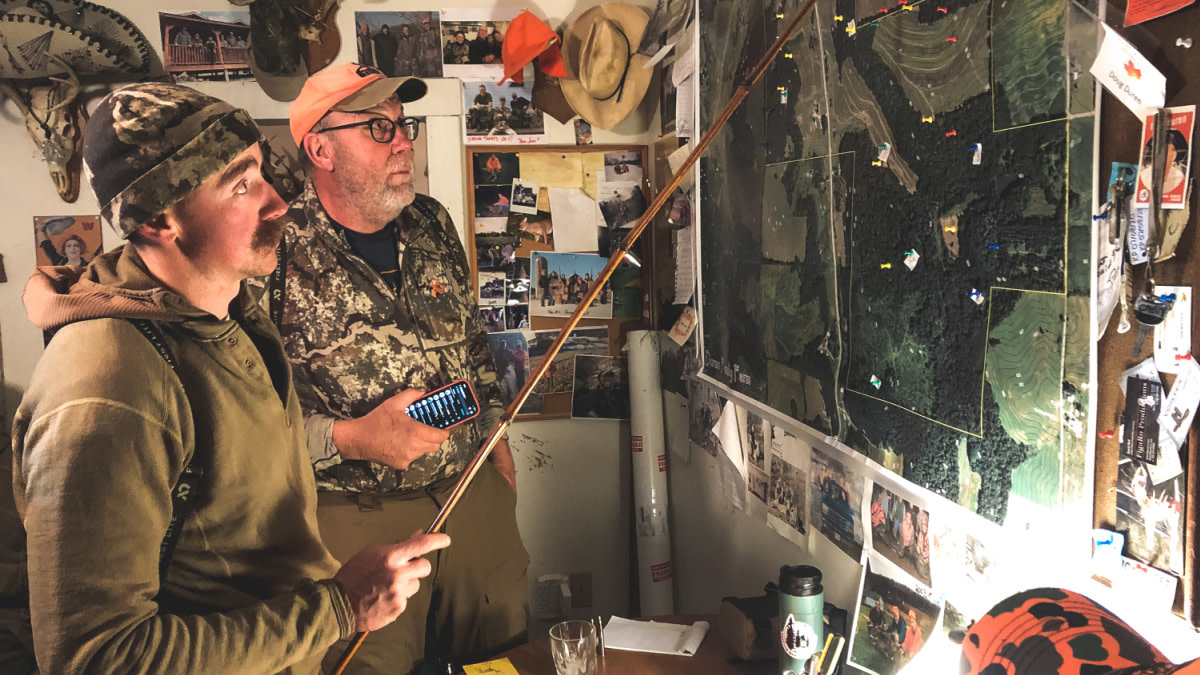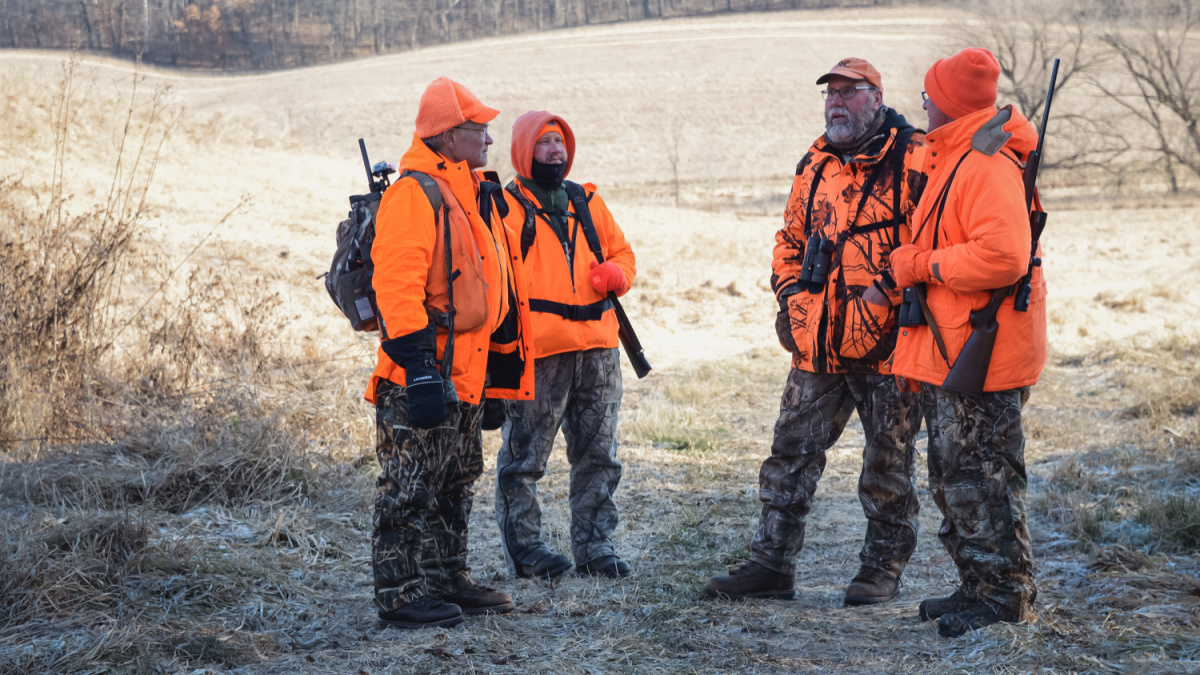
Overnight winds had swept the oaks below, blowing fresh snow into drifts higher than a whitetail’s brisket.
I knew the snow’s depth because a doe crossing the woods below me was plowing a furrow in the fluffy blanket as she approached. The doe paused occasionally in her midmorning stroll to browse buds and stems, and finally walked broadside at 100 yards into a shooting lane. I put the riflescope’s crosshairs on her shoulder blade and fired my .35 Whelen. The doe collapsed where she stood, her head half-buried in the soft snow.
Doug Duren arrived an hour later to help drag, hear my story, and gloat a bit about another successful “mooch” on his family’s farm in southwestern Wisconsin. The day was Jan. 1, 2009, and we had met in person for the first time just hours earlier in the predawn darkness. Duren invited me inside his old farmhouse for introductions and a strategy session over maps and coffee. He then led our group of six across the two-lane highway bisecting his farm, and through the deep snow covering the stubble of a chopped cornfield.
We then split up, with me and Chuck Keller following Duren up the spine of a long ridge. When Duren peeled southward to slowly circle the hill, Keller and I kept marching eastward. Keller stopped and scaled a ladder stand on the next knob, and I stopped five minutes later upon reaching the property boundary’s fence-line gate. Meanwhile, Tyson Hall and brothers Greg and Tim Kiefer trudged to their designated posts to the north. Shane Marquardt brought up the rear, arriving about 8 a.m.
As Duren instructed, I moved northward about 9:30 to sit atop a limestone outcrop after seeing nothing by the boundary gate. He said this particular “mooch” had some history. Experience told him that he might nudge a deer through the wooded valley below the ridge after he was halfway through his orbit around the hill.
What’s a Mooch? I had enough experience to not ignore a landowner’s instructions, especially one who’s hunted the property for 40 years. Even so, I kept asking myself: “What’s a mooch? And how can it be a noun, verb, and deer hunting strategy all at the same time?”
I’d heard salmon anglers use the term, of course. As Trevor Bellrichard shared on Instagram, the word “mooch” describes vertical jigging for salmon. Mooching rigs are great for salmon, but I doubted any relevance to the deer woods.
Duren later explained the word’s use and etymology in deer hunting, which dated at least to his father, Vince, and uncle Ralph Zielinski. Duren’s elders hunted deer with family, friends, and fellow World War II veterans in Wisconsin’s northern forests near Phillips and Clam Lake, as well as the state’s central woodlands near Redgranite.
They hunted slowly from the ground, taking turns as standers and still-hunters to nudge deer past each other. If they used the wind, terrain, and deer’s escape patterns correctly, they caused deer to skulk and sneak around them, rather than blast into the next county in panicked fright. Duren said a well-executed mooch gives standers and moochers equal shooting opportunities, with shots few but deliberate.
Duren recalls his father taking him “up north” in the early 1970s to hunt deer. He saw only one deer before Uncle Ralph shot a buck the third year. “Hunting up there was a waste of time if you really wanted to kill a deer,” Duren said. “Ralph had a .30-40 Krag with iron sights, and we were really stumped when he shot a buck. He got it by sneaking along, but he called it mooching. He said, ‘I knew you guys were out hunting, and I thought I’d try to get some deer moving. So, I started mooching around.’ I’ll never forget him describing it as mooching because I didn’t know what he meant.”
Duren eventually grasped the meaning of mooch, and has since made mooching a core tactic on his family’s farm. An individual mooch, when combined with mooches made by fellow moochers, creates one overall mooch, much as individual drivers combine to create a drive. When hunting with Duren, you mooch by moving glacier-like along a precise route he designates, whether it takes you through a woodlot, along its border with a field of corn or alfalfa, or down a hollow and up the next ridge. In short, moochers do what Duren says, and follow their assigned routes at speeds somewhere between loitering and stalking.
Mooching’s Deeper Roots Fifty years after adopting Uncle Ralph’s hunting methods, Duren remains among a select few hunters still using his uncle’s terms. Mooching coinages, however, aren’t unique to Duren’s clan. They’re likely rooted in northwestern Wisconsin, where the Durens just happened to be hunting. The term also appears in a 1950s-era hunting story by Gordon MacQuarrie, a popular magazine writer and the Milwaukee Journal’s outdoor columnist.
MacQuarrie’s short story, “You’ve Got to Suffer!,” is an autobiographical account of an opening-weekend deer hunt. Heavy snow smothered the forest when his father-in-law asked him to make “one little drive” for him, MacQuarrie refused, saying, “I’m not mooching in this snow.”
MacQuarrie eventually gave in when “Mr. President” offered up his snowshoes and told him to wear off some of their varnish. MacQuarrie soon nudged a deer toward the “Old Man,” much in the same way Duren intends when plotting and executing mooches on his farm seven decades later and 200 miles to the south.
MacQuarrie wrote: “The deer was moving ahead of me. Buck or doe? I do not know. This deer was not plunging. It seemed to know my pace and kept just ahead of me. Likely it had heard me when I was a hundred yards away, and got up quietly and just sneaked away. Deer can be very contemptuous of a man.”
Keith Crowley, author of “Gordon MacQuarrie: The Story of an Old Duck Hunter,” was surprised to hear that Duren still says “mooch” and “mooching,” and was impressed that he uses both words correctly.
“It's probably been 25 years since I heard those terms up here in MacQuarrie Country,” Crowley said. “I'm afraid the term ‘mooching’ is gone in northwestern Wisconsin’s deer woods. I’m willing to try bringing it back, though!”
Can folks like Duren and Crowley salvage “mooch” from the dustbin of deer hunting’s dictionary? Maybe, but it won’t be easy. When I asked folks on Instagram if they’ve heard or used “mooch” as Duren and MacQuarrie describe it, only three of 147 respondents (2%) replied “yes.” Of those three, two were Wisconsinites and the other an Australian.

Rare Moochers Ken Fenton of Hayward in northwestern Wisconsin said he’s used “push” and “mooch” interchangeably when hunting favorite ridges and named places with friends and family.
“A couple of our guys couldn’t sit still more than a couple of hours,” Fenton wrote. “They would start mooching to other people’s stands. That was before the days of baiting and treestands. We shot a number of deer this way.”
Mike Johnson of southwestern Wisconsin wrote: “We have the person work a patch of woods upwind, and slowly mooch through the woods, letting their scent move the deer. A drive is just sound, activity, and movement.”
And Luke Seib of Brisbane Valley, Australia, wrote: “We’ve always called it ‘mooching’ when taking our time to get through good deer country. Dunno where we got it from.”
Maxwell A. Duqette of Vermont thinks the term likely originated in England, noting the British often use “mooch” to describe someone who skulks around or walks aimlessly “with a particular eye toward finding something to eat.” Duquette said the British also use “mooch” to describe the way drunks stumble around after bar time to “find a bite.”
Adding credence to Duquette’s theory is England’s Cambridge Dictionary, which lists these synonyms for mooch and mooching: amble, meander, mince, mincing, putter, tiptoe, and wander.
Likewise, the Merriam-Webster Dictionary—“America's foremost publisher of language-related reference works”—traced “mooch” as a verb to 1851. That original usage defined it as someone “mooching around the background and keeping an eye on us.” But since its first known use as a noun in 1914, most Americans use “mooch” to describe someone who begs or leeches off of others, targets freebies at food courts, or sneaks away to the restroom when the bar or dinner tab arrives.
The Meaning of Mooch In other words, Americans changed the main meaning of “mooch” the past century. Some even apply “mooch” to freeloading deer-drive behaviors. As Bo Schumacher of De Pere, Wisconsin, wrote on Instagram: “A mooch is the guy who purposely sits on an adjacent property while people drive their land. The mooch does none of the work while reaping the rewards of other hunters’ time and effort.”
Besides, deer hunters have settled on more popular words for mooch, moochers and mooching. Some even shun those terms. Ron Boehm, Steve Rinella’s lifelong friend and host of The Hunting Dog Podcast, tersely wrote: “Ridiculous use of a word. Drive or driven.”
Based on my Instagram feedback, most hunters also distinguish between a “push” and a “drive,” noting that pushes are often short, slow, impromptu efforts involving few hunters and small parcels. Drives, meanwhile, usually move faster, last longer, and involve several hunters and larger properties. But drives can also be quiet or loud, named or numbered, and carried out by people (man-drive) or beasts (dog-drive, horse-drive), varying by region and history.
Other preferred deer hunting words and terms related to mooch are sneak, creep, mosey, nudge, bump, still-hunting, and mousing around. Still other hunters nudge deer onto their hooves by taking a slow walk, stirring the pot, or grabbing a scattergun to hunt grouse. Deer-drive tactics, meanwhile, can also involve runners, doggers, drivers, pushers, blockers, sitters, and standers.
The only similar term mentioned less often than “mooch” came from Max Kulick. When Kulick’s father still-hunts/wind bumps their property’s central Wisconsin honey holes while the others wait in strategically placed “getaway stands,” they call it “poochin’.”
Duren, of course, doesn’t care if other hunters use or endorse “mooch” as a noun, verb, adjective, or putdown. He’s just flattered that many MeatEater fans adopted the term after hearing it on Netflix and podcasts. He also wants everyone to know the tactic works great for hunting trophies or nubbin bucks during gun season. His farm produces plenty of both.
The Perfect Mooch “I never liked traditional drives because deer bust out hauling ass,” Duren said. “At that speed, you can’t take an ethical shot. I also don’t want to run deer off the property. If the moocher does it right, deer let you move by, or they sneak away and circle into someone else in the group. Whoever gets the shot has a good opportunity for a clean kill.”
Duren said an effective mooch requires planning, good communication, and knowledge of wind patterns and deer behavior. He starts by consulting his smartphone for wind and weather forecasts, and then gathers his group before a large aerial photo of his 400-acre farm, which pinpoints each stand’s location. He then explains the mooch’s objective, assigns hunters to stands, pulls his bamboo pointer or tree-measuring stick from the corner, and traces each moocher’s route on the big aerial photo while describing the plan.
Once the mooch begins, the group uses text-messages and onX to keep everyone on track and on schedule. Wisconsin allows electronic communications while hunting, and smartphones with GPS keep newcomers from straying onto neighboring properties.
When hearing Duren discuss the perfect mooch, it’s easy to see similarities to a passage from “Shots at Whitetails,” a classic book (1948) by Lawrence R. Koller. Koller, a well-known hunter and gunsmith from New York’s Adirondack region, wrote this comparison of still-drives and noisy drives:
“The best policy is the still-drive, in which drivers still-hunt through the woods to standers. This system has a prime advantage over noisy drives—it keeps deer constantly guessing the exact whereabouts of each hunter. As a result, they tend to move slowly ahead of the drivers, and when they approach the stands the watchers get a better shot. The best any drive can do is start deer moving and keep them moving until they find their way out, using favored escape routes. (The still-drive) requires hunters to study their ground and apply woodcraft logic to each drive. If the hunters do the requisite scouting, drives produce more venison for the group than any other method.”
"My Favorite Way to Hunt Deer" Duren, likewise, considers teamwork a critical part of each mooch.
“You just take your time, work together, and put people where they’re most likely to succeed,” he said. “It’s a team effort, not a solitary pursuit. It’s also not about pushers and blockers, beating on pots and pans, and trying to kill every deer you can. Those old-time noisy drives always struck me as a sign of desperation. Things often got chaotic. Deer went flying everywhere, and so did the lead.
“A mooch is more about planning, hunting your plan, picking stands where deer move to avoid danger, and taking careful shots when they arrive. A good mooch can take all morning, all day, or just a couple of hours. It’s not hard-ass hunting. It’s more relaxed. It’ll always be my favorite way to hunt deer.”







Conversation